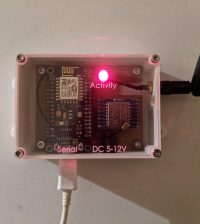- makeITcircular 2024 content launched – Part of Maker Faire Rome 2024Posted 2 weeks ago
- Application For Maker Faire Rome 2024: Deadline June 20thPosted 2 months ago
- Building a 3D Digital Clock with ArduinoPosted 7 months ago
- Creating a controller for Minecraft with realistic body movements using ArduinoPosted 7 months ago
- Snowflake with ArduinoPosted 8 months ago
- Holographic Christmas TreePosted 8 months ago
- Segstick: Build Your Own Self-Balancing Vehicle in Just 2 Days with ArduinoPosted 8 months ago
- ZSWatch: An Open-Source Smartwatch Project Based on the Zephyr Operating SystemPosted 9 months ago
- What is IoT and which devices to usePosted 9 months ago
- Maker Faire Rome Unveils Thrilling “Padel Smash Future” Pavilion for Sports EnthusiastsPosted 10 months ago
Time is linear, so you need an Arduino linear clock!

Assuming that time is linear, Jonathan Odom has decided to create a clock illustrating time’s linearity.
He built a beautifully crafted clock that uses two rack and pinion assemblies to move a line of numbers for hours on top of another line signifying minutes.
He made it using every machine at Pier9 workshop (3D printer, laser cutter, san blaster…). Ok, not many people have access to a shop like Pier9, but I think Jonathan could provide a good starting point for every maker.
The minute “hand” is divided up into five-minute intervals, which seems to him to feel less neurotic than being precise down to the exact minute. Magnifying glasses are used to magnify an hour and minute number, reminding onlookers to focus on the present.
The clock is actuated using an Arduino Uno with a motor driver, controlling a stepper motor for each hand.
“Here’s the basic idea of how I want it to work:
-
When the unit is turned on, the steppers run the racks back until the limit switches on the left side are triggered. This sets the position to zero. The steppers then run the racks forward until 1 is centered on the hour panel and 00 is centered on the minute panel.
-
Once the hour and minute is centered, the racks move forward in time. A full position move on the bottom at full speed every 5 minutes, and a full position move on the top every hour.
-
The momentary switches (pins 6-7) to move the racks forward by one position (about 147 steps), then continue with the clock counting.
-
The hour and minute movements have counters that send the bars back to the left limit switches and reset them to zero once hour has gone past 12, and the minutes have gone past 55.”
Click here for further informations.















